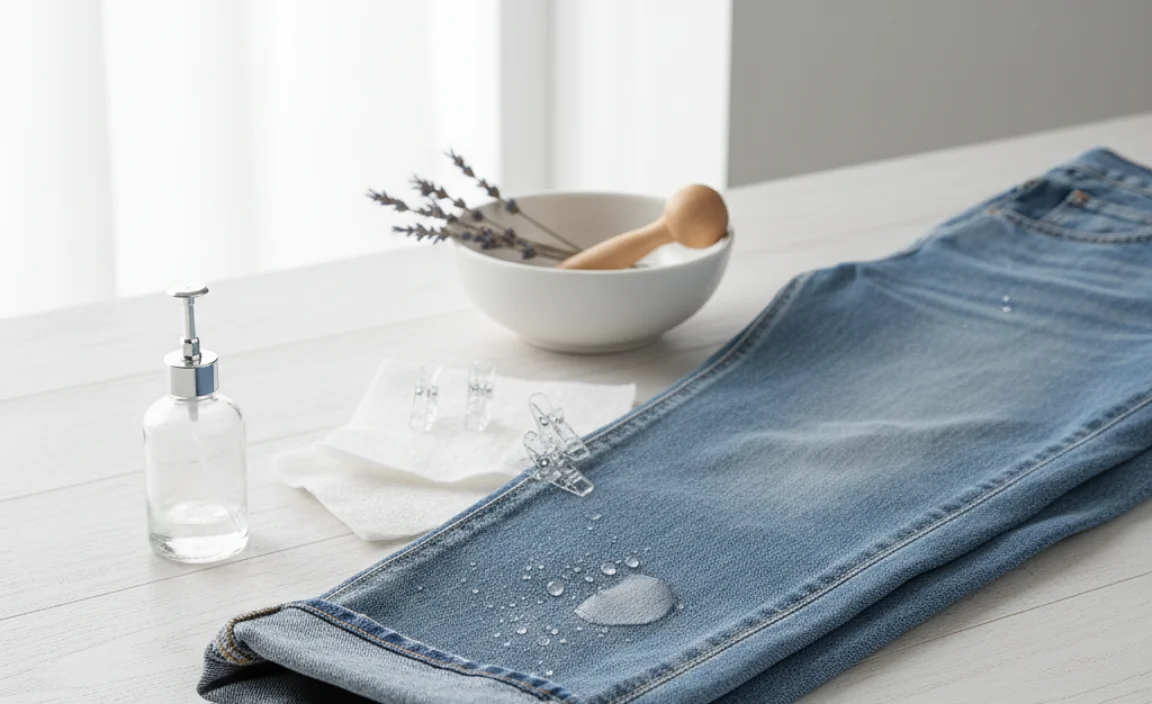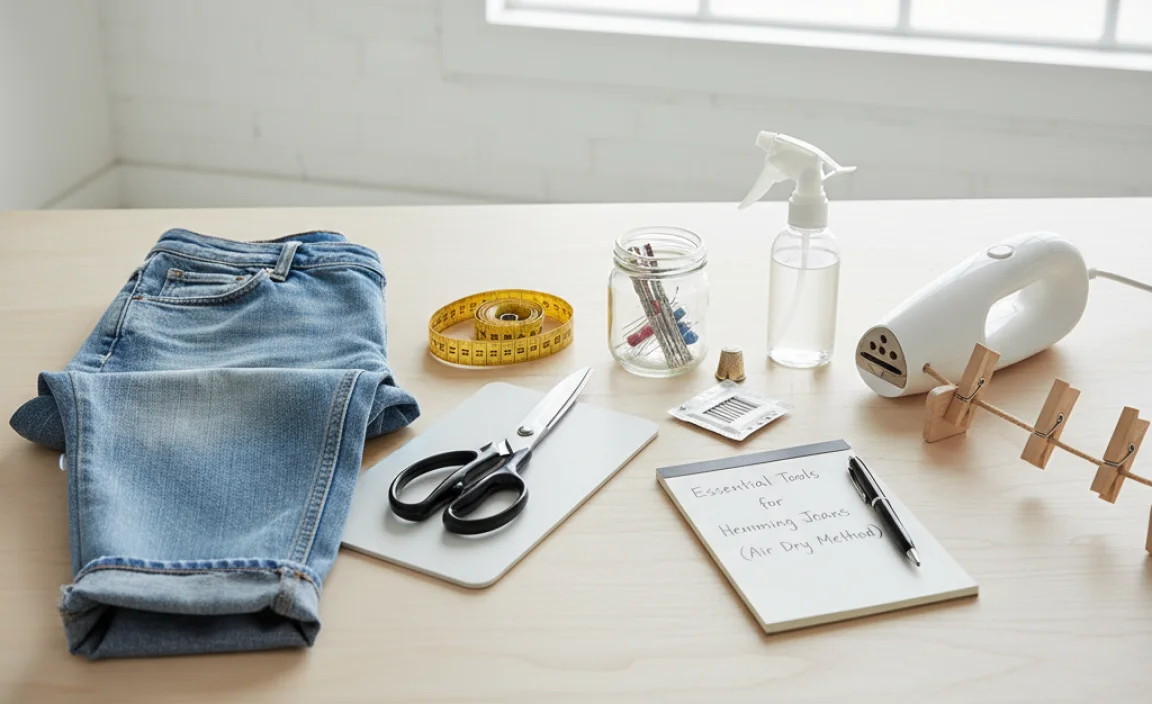To hem relaxed jeans using only air drying, you’ll need a measuring tape, fabric scissors, chalk or a fabric marker, and straight pins. This method focuses on achieving a clean hem without heat setting, making it ideal for preserving denim integrity and achieving a casual, lived-in look. Follow these simple steps for a perfect, no-fuss finish.
How To Hem Relaxed Jeans: Effortless Air Dry Method
Are your favorite relaxed-fit jeans a little too long, dragging on the floor and looking a bit sloppy? You’re not alone! Finding that perfect length can be tricky, but the good news is you can easily adjust them yourself. This guide is designed to help you hem your relaxed jeans using a simple air-dry method. We’ll walk you through each step clearly, so you can achieve a clean, professional-looking hem without needing a sewing machine or any complicated equipment. Get ready to give your jeans a fresh, tailored fit that feels just right.
Why Choose the Air Dry Method for Hemming?

When it comes to hemming jeans, especially relaxed fits, the air dry method offers several advantages that align with the natural drape and texture of denim. Unlike methods involving heat (like ironing or machine drying), air drying preserves the fabric’s natural fibers and avoids any potential shrinkage or damage. This is particularly important for relaxed jeans, which are designed for comfort and have a looser fit that can be altered negatively by heat. The air-dry approach ensures the hem sets naturally, maintaining the denim’s character and providing a softer, more authentic look.
Understanding Your Relaxed Fit Jeans

Relaxed fit jeans are characterized by their comfortable, looser silhouette. They typically offer more room through the seat, thigh, and leg compared to straight leg or slim fit styles. This extra room is what gives them their signature comfort and laid-back vibe. When hemming, it’s crucial to maintain this relaxed feel. Simply cutting off the excess length and leaving a raw edge might seem easy, but it can lead to excessive fraying or an unfinished look. Our air dry method aims to create a clean, controlled hem that complements the relaxed style without stiffness.
Essential Tools for Hemming Jeans (Air Dry Method)

Before you begin, gather these basic tools. Having everything ready will make the process smooth and efficient. Remember, precision is key, and the right tools ensure a neat finish.
- Measuring Tape: Essential for accurately measuring the desired length. A flexible tailor’s tape measure is ideal.
- Fabric Scissors: Sharp scissors specifically for fabric will give you clean cuts. Dull scissors can snag and distort the denim. For an authentic fray, consider using pinking shears for the inner edge.
- Fabric Chalk or Marker: Used to mark the hemline accurately. Choose a color that contrasts with your denim. Washable fabric markers are a good choice.
- Straight Pins: To hold the fabric in place while you measure and mark. Fine, sharp pins work best.
- Iron (Optional, for prep): While the drying is air-only, an iron can be used before pinning to press the intended fold for a crisper initial line, though this step can be skipped if you prefer a more entirely “natural” feel.
- Darning Needle and Thread (Optional, for optional secure hem): If you wish to secure the hem more permanently without sewing, a needle and thread can stitch the folded edge in place invisibly.
Step-by-Step: How to Hem Relaxed Jeans (Air Dry Only)

Here’s how to achieve a perfectly hemmed pair of relaxed jeans using the air dry method. We’re focusing on a clean, finished hem that doesn’t require any heat setting.
Step 1: Prepare Your Jeans
Start by washing and drying your jeans as you normally would. This ensures you’re working with their final, true size, preventing any surprises after hemming. Lay the jeans flat on a clean, hard surface. Smooth out any wrinkles carefully. Since we are air-drying the hem, it’s important to have the fabric ready to be marked without any existing creases that might interfere with your measurements.
Step 2: Determine Your Desired Length
Put on the jeans and a pair of shoes you typically wear with them. Stand in front of a mirror. Decide where you want the hem to fall. For relaxed jeans, aim for the hem to sit just at the top of your shoe or slightly above. If you prefer a slightly longer look that can still accommodate shoes, measure from the crotch seam down to where you want the hem to end. Or, have someone help you mark the length while you are wearing them. Use a measuring tape held vertically against your leg to find the current hem length and decide how much to take off.
Step 3: Mark the Hemline
Once you know the desired length, take off the jeans. Lay them flat again. Measure from the bottom hem upwards to your determined marking point. Use your fabric chalk or marker to make a small dot or line at this point on the outer seam, inner seam, and possibly the center of the leg on each pant leg. Repeat this process for all points you need to mark, ensuring they are consistent across both legs. A consistent line is crucial for a professional look.
Pro Tip: Measure and mark from the crotch seam down for the most accurate length measurement, especially with relaxed fits that can vary in rise. A common method is to mark the desired length on the inseam (the inner seam) and transfer that measurement around the entire leg opening.
Step 4: Fold and Pin the Hem
Now, it’s time to create the fold. Fold the bottom of each pant leg upwards, aligning the raw edge with your marked line. For a clean, finished hem that air dries well and doesn’t unravel easily, you’ll want to fold up about 1 inch (2.5 cm). Press this fold gently with your hand to set a temporary crease. Then, use your straight pins to secure this fold in place. Place pins closely together, about every 1/2 inch (1.3 cm), to ensure the fabric stays put while it dries. Make sure the pins are going through both layers of fabric.
Tip for a Tidy Edge: If this is your first time, you might want to practice folding on a scrap piece of denim. For a more permanent, neat finish that still air dries, you could use a needle and a few strategically placed, small stitches to hold the folded hem in place before letting it air dry. This adds stability without requiring heat-setting.
Step 5: The Air Drying Process
This is the core of the “air dry” method. Once pinned securely, hang your jeans up to air dry. Ensure they are hung in a way that allows air to circulate freely around the pinned hem. A clothes hanger with clips is perfect for this. Avoid direct sunlight if you don’t want the denim to fade unevenly. Allow the jeans to dry completely. This might take 12-24 hours or longer, depending on humidity and air circulation. The goal is for the fabric to naturally set in its folded position.
Important Note on Air Drying: The key is patience. Do not rush the drying process or try to speed it up with heat. Ambient air drying allows the denim fibers to settle and hold the shape of the hem without being stiffened by heat.
Step 6: Final Check and Finishing Touches
Once completely dry, carefully remove the pins. The hem should now hold its folded shape. Try on your jeans to check the length and drape. If you are happy with the result, you can leave the hem as is for a clean, no-fray edge. If you prefer a bit of fraying for a more casual look, you can carefully snip a few threads along the very bottom edge to encourage gentle fraying over time. For those who want a slightly more secure hem without heat, you can take a needle and thread and make a few discreet stitches along the inside of the folded hem to keep it from unfolding.
Consider using a contrasting thread color for a decorative stitch on the inside, or matching thread for an invisible finish. This step is entirely optional for the air-dry method but adds a layer of security for daily wear.
Maintaining Your Hemmed Jeans

After successfully hemming your relaxed jeans, proper care will ensure they maintain their new length and style. Washing them inside out in cold water and air drying them whenever possible will help preserve the denim’s color and prevent premature wear. When you need to wash them, always hang them to dry, especially after hemming, to ensure the fabric maintains its shape without creasing in unwanted places.
Troubleshooting Common Hemming Issues
Even with simple methods, sometimes things don’t go as planned. Here are a few common issues and how to fix them:
- Uneven Hem: This is usually due to inconsistent marking or folding. Carefully unpick your pins, re-measure and re-mark your line, ensuring accuracy on all sides of the leg. Laying flat and using a ruler or long straight edge can help transfer marks around the leg.
- Fabric Puckering: This can happen if pins are too far apart or the fabric wasn’t smoothed properly before pinning. Re-pin more closely, ensuring both layers of denim are flat and smooth.
- Hem Unraveling (if left raw): If you opted for a raw hem and it’s fraying more than desired, you can use a product like Fray Check (available at most craft stores) along the underside of the hem to stop further unraveling.
- Jeans Still Too Long: It’s always better to start with a slightly longer measurement; you can always trim more. If they’re still too long after your first attempt, repeat the marking and folding process, ensuring you measure from the new folded edge.
Pros and Cons of the Air Dry Hemming Method
Like any DIY technique, the air dry hemming method has its advantages and disadvantages. Understanding these can help you decide if it’s the right approach for your jeans project.
| Pros | Cons |
|---|---|
| Preserves original denim texture and color, avoiding heat damage. | Takes longer than heat-set methods due to reliance on natural drying. |
| Achieves a natural, lived-in look without stiffness. | May require more careful pinning to ensure the fold holds its shape. |
| No special equipment or machines needed, making it beginner-friendly. | The hem might feel less structured initially if not secured with a few stitches. |
| Environmentally friendly, using no energy for heat. | Results can vary slightly with humidity levels, affecting drying time. |
| Ideal for maintaining the inherent relaxed feel of the jeans. | For a very crisp, permanent crease, a bit of ironing might be preferred by some, though this guide focuses on no-heat. |
Maintaining the Integrity of Your Denim
Denim is a durable fabric, but how you care for it, especially after making alterations, plays a significant role in its longevity. For your newly hemmed relaxed jeans, consider these points:
- Wash Less, Air More: Frequent washing can wear down denim fibers. Spot clean minor stains when possible. When washing is necessary, opt for cold water and a gentle cycle.
- Inside Out is Best: Always wash jeans inside out. This protects the outer surface from abrasion and helps preserve the color of the denim.
- Air Dry Whenever Possible: Even without hemming, air drying is kinder to denim than machine drying. It prevents shrinkage, reduces wear, and helps maintain the fabric’s shape. For your specific project, continuing to air dry after washing is paramount to keeping the hem’s integrity. You can find tips on effective air drying techniques from resources like EPA’s recycling basics, which often touches on sustainable practices like line drying as a form of resource conservation.
- Gentle Folding: When storing your jeans, fold them neatly. Avoid cramming them into drawers, which can create new, unwanted creases.
FAQ: Hemming Relaxed Jeans with Air Drying
What is the best way to measure for hemming jeans?
The most accurate way is to wear the jeans with the shoes you plan to wear them with, stand in front of a mirror, and mark the desired length. Alternatively, lay the jeans flat and measure from the crotch seam down the inseam to your desired length.
Can I hem jeans without sewing?
Yes! While sewing provides the most durable and structured hem, you can achieve a temporary or even long-lasting hem through methods like fabric glue, hemming tape, or even careful pinning and air drying, as described in this guide.
How much should I fold up when hemming jeans?
For a clean, finished hem that doesn’t fray excessively, a 1-inch (2.5 cm) fold is standard. If you want a double-folded hem for extra neatness and to completely hide the raw edge, fold up 1/2 inch first, then fold up another 1 inch over that.
Will air drying make my jeans stiff?
No, air drying is the opposite of heat setting. It allows the fabric to dry naturally and maintain its soft, pliable texture without the stiffness that ironing or machine-drying can sometimes impart.
How long does it take for a hem to air dry and set?
Drying time varies depending on humidity and air circulation. Typically, it can take 12 to 24 hours, or sometimes longer, for the fabric to dry completely and naturally set into the folded shape.
What if my relaxed jeans have stretchy denim?
Stretch denim can be even easier to work with for hemming. The fold should hold its shape well due to the elasticity. Ensure you’re measuring and pinning while the jeans are laid flat or worn to account for any stretch that might occur when wearing them.
Can I create a raw hem with air drying?
You can cut your jeans to the desired length and allow them to air dry. However, to prevent excessive fraying and maintain a neat appearance, you might want to do a small inner fold (about 1/4 inch) and secure it with very small, occasional stitches or fabric glue before allowing it to air out, guiding the ‘raw’ fraying to a controlled edge.
Conclusion
Hemming your relaxed jeans using the effortless air dry method is a straightforward and effective way to achieve a perfect fit without complicated tools or heat. By carefully measuring, marking, and pinning, you can create a clean, natural-looking hem that complements the relaxed style of your denim. This approach not only preserves the integrity of your jeans but also ensures they remain comfortable and stylish. With a little patience during the air-drying phase, you’ll end up with a pair of jeans that fit you as if they were custom-made, ready for any occasion. Enjoy your perfectly shortened, no-fuss relaxed jeans!











